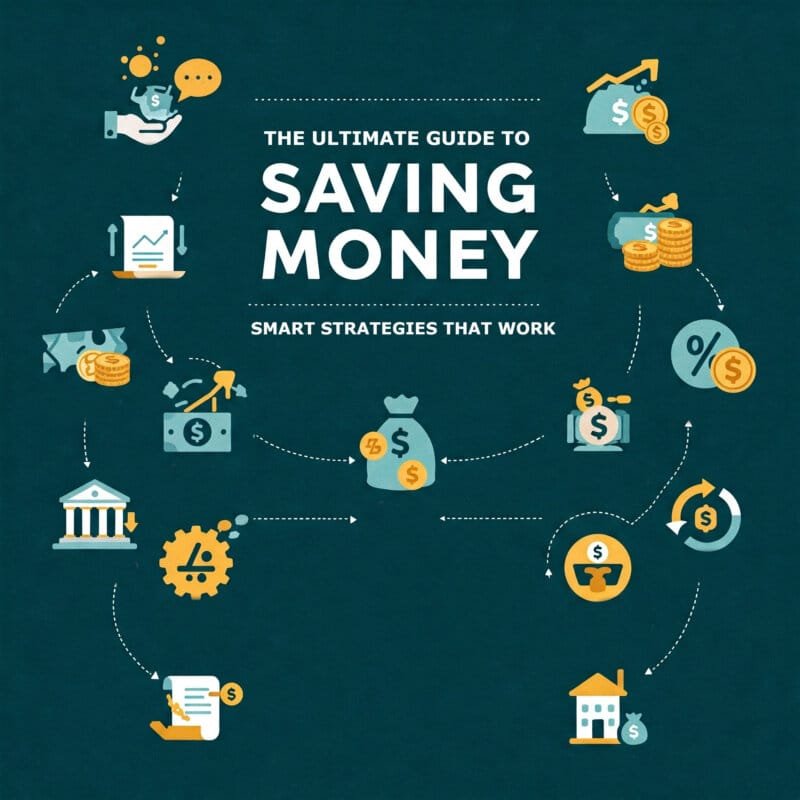The Ultimate Guide to Saving Money: 30+ Smart Strategies That Work
Introduction: Why Saving Money Matters
In today’s economy, finding effective ways to save money is more important than ever. Whether you’re trying to:
✔ Build an emergency fund
✔ Pay off debt
✔ Save for a big purchase
✔ Plan for retirement
Learning and implementing smart money-saving strategies can help you achieve financial freedom faster while maintaining your lifestyle.
This comprehensive guide covers 30+ actionable tips across 7 key areas of personal finance. By implementing even a few of these strategies, you could save hundreds or even thousands per year.
Section 1: Budgeting & Financial Planning (The Foundation)
| 1. The 50/30/20 Budget Rule | This foundational method allocates after-tax income to: 50% Needs: Rent, groceries, utilities, minimum debt payments 30% Wants: Dining out, entertainment, hobbies 20% Savings/Debt: Emergency fund, retirement, extra debt payments Pro Tip: Use YNAB or EveryDollar to automate tracking. |
| 2. Zero-Based Budgeting | Assign every dollar a job each month: 1. List all income sources 2. Account for all expenses (down to $5 coffee) 3. Adjust until income minus expenses equals zero Best for: Those who want complete control over spending |
| 3. Pay Yourself First | Before paying bills: • Automate 10-20% to high-yield savings • Contribute to retirement accounts • Pay extra on high-interest debt Example: $3,000 paycheck → $600 saved automatically |
| 4. Weekly Cash Challenge | Withdraw fixed amounts for: • Groceries ($150/week) • Entertainment ($75/week) • Personal spending ($50/week) When cash is gone, spending stops until next week. |
| 5. Biweekly Budget Boost | If paid biweekly: • Budget for 2 paychecks/month • Use 2 “extra” annual paychecks for: – Debt payoff – Vacation fund – Emergency savings Potential: $3,000+/year extra |
Section 2: Cutting Fixed Expenses (Big Savings)
| 6. Bill Negotiation Blueprint | Call providers with this script: “I’ve been a customer for X years but found [competitor] offering [better deal]. Can you match this or should I switch?” Success rates: • Internet: 73% success • Cell phone: 68% • Cable: 61% |
| 7. Subscription Purge | Audit monthly: 1. List all subscriptions ($5-$100+/month) 2. Cancel unused services (avg. $200/year wasted) 3. Use Rocket Money to track recurring charges Common offenders: Forgotten apps, premium memberships |
| 8. Energy Savings Hack | Instant savings: • LED bulbs (save $75/year) • Smart thermostat ($100/year) • Unplug devices ($50/year) Long-term: • Insulation upgrades • Energy Star appliances • Solar panel leasing |
| 9. Insurance Optimization | Annual checkup: 1. Compare rates at TheZebra.com 2. Increase deductibles if possible 3. Bundle home/auto (avg. 15% discount) Potential savings: $500+/year |
Section 3: Smart Shopping Strategies
| 10. The 30-Day Rule | For all non-essentials: 1. Add to wishlist 2. Set 30-day reminder 3. If still needed, buy Results: Cuts impulse spending by 60-70% |
| 11. Grocery Game Plan | Pro strategies: • Shop after eating (reduces impulse buys 23%) • Buy generic (avg. 30% cheaper) • Use Flipp app for circulars Annual savings: $1,500+ for families |
| 12. Secondhand Goldmine | Best deals: • Cars: 1-3 years old (save 20-40%) • Furniture: Facebook Marketplace • Electronics: BackMarket (refurbished) • Kids items: Once Upon A Child Quality tip: Check return policies |
Section 4: Increasing Your Income
| 13. Side Hustle Matrix | Top earners: • Freelancing (Upwork/Fiverr): $25-$100/hr • Tutoring (Wyzant): $40-$80/hr • Delivery (Instacart): $15-$30/hr Passive options: • Rent storage space • Print-on-demand stores |
| 14. Raise Negotiation Script | Proven approach: 1. Research salaries on Glassdoor 2. Document achievements (use numbers) 3. Say: “Based on my contributions [list], I’m requesting a [X]% adjustment to match market rates.” Success rate: 85% when prepared |
Section 5: Banking & Credit Optimization
| 15. High-Yield Savings | Top 2025 accounts: • CIT Bank: 5.05% APY • Marcus: 4.50% • Ally: 4.25% Key: FDIC insured, no fees, easy transfers |
| 16. Credit Card Stacking | Optimal combo: • Groceries: Amex Blue Cash (6%) • Gas: Citi Custom Cash (5%) • Everything else: Fidelity Visa (2%) Rule: Always pay in full |
Section 6: Lifestyle Changes for Long-Term Savings
| 17. Minimalist Framework | The 90/90 Rule: If you haven’t used it in 90 days AND won’t use it in next 90 days → Sell/donate Benefits: • Less clutter • More mindful spending • Extra cash from sales |
| 18. Preventive Healthcare | Cost-saving habits: • Annual physicals (catches issues early) • Dental cleanings (prevents costly procedures) • Generic medications (ask your doctor) Savings: $5,000+/year in avoided treatments |
Section 7: Advanced Wealth-Building Strategies
| 19. Investment Ladder | Beginner portfolio: 1. Emergency fund (3-6 months) 2. 401(k) up to employer match 3. Roth IRA ($7,000/year) 4. Taxable brokerage account Tools: Vanguard/Fidelity index funds |
| 20. Real Estate Alternatives | No-property options: • REITs (Fundrise) • Crowdfunding (Arrived Homes) • Airbnb arbitrage Minimums: $10-$500 to start |
FAQs
Q: How much should I save monthly?
A: Aim for 20% of income. If that’s impossible, start with 5% and increase gradually.
Q: What are the best ways to save money on a tight budget?
Start with these money saving tips: track spending, meal plan, cancel unused subscriptions, and use cash-back apps. Even saving $5/day add up to $1825/year!
Q: How to save money fast for an emergency fund?
A: Combine budgeting strategies (like the 50/30/20 rule) with quick wins: sell unused items, take surveys (Swagbucks), and slash dining out. Many save $500+/month this way.
Q: What are unusual but effective money saving tips?
A: Try these frugal living hacks:
“No-spend” weekends
Library for free entertainment
Price-match guarantees at stores
Bartering skills for services
Q: Which budgeting strategies help save the most money?
A: The top ways to save money include:
Zero-based budgeting
Cash envelope system
Automating savings
Weekly spending audits
Q: How can I practice frugal living without feeling deprived?
A: Focus on value: buy quality used items, host potlucks instead of dining out, and use money saving tips like loyalty programs. It’s about spending smarter, not less.
Q: What’s the fastest way to save $10,000?
A: Use budgeting strategies to cut $500/month and boost income $500/month (side hustles like freelancing). This how to save money fast approach hits $10k in just 10 months.
Your Money-Saving Journey Starts Now: Take Action & Transform Your Finances
Saving money isn’t about restriction—it’s about freedom. The freedom to:
✔ Pursue your dreams without debt holding you back
✔ Handle emergencies without stress
✔ Build wealth that grows over time
Here’s your step-by-step action plan to make it happen:
1. Start Small, Win Big
You don’t need to overhaul your life overnight. Pick just 3 strategies from this guide to implement this week:
- Automate $50 to savings
- Cancel one unused subscription
- Try one no-spend day
Why this works: Small wins build momentum. Saving $20/week=$1,040/year.
2. Track & Celebrate Progress
Use this simple tracker for your first month:
| Week | Strategy Implemented | Amount Saved |
|---|---|---|
| 1 | Canceled Netflix + ate out 1x less | $45 |
| 2 | Switched to generic brands | $28 |
| 3 | Negotiated internet bill | $15/month |
Pro Tip: Take a screenshot of your progress and make it your phone wallpaper for motivation.
3. Level Up Your Savings
Once comfortable, add one advanced strategy per month:
- Month 2: Start a side hustle (Freelance? Sell unused items?)
- Month 3: Optimize credit cards for cash back
- Month 4: Invest your first $100
4. Protect Against Relapse
We all slip up. When you overspend:
- Don’t guilt-trip yourself – Even millionaires make mistakes
- Analyze why (Boredom? Stress?)
- Reset immediately – Next meal at home, next purchase delayed 24 hours
Real People, Real Results
“Using just the bill negotiation and grocery tips, I saved $3,200 in 6 months—enough for my dream vacation!”
– Sarah K., Ohio
“The 30-day rule stopped my $300/month Amazon habit. Now that money goes to my Roth IRA.”
– Mark T., Texas
Your Next Steps
- Bookmark this page – Revisit when you need motivation
- Share your goal – Accountability increases success rates by 65%
- Start today – Even $5 saved is progress
Remember: Financial freedom isn’t about perfection. It’s about persistent progress. Every dollar saved moves you closer to a life with less stress and more possibilities.
💬 Which strategy will you try first? Commit in the comments below!

